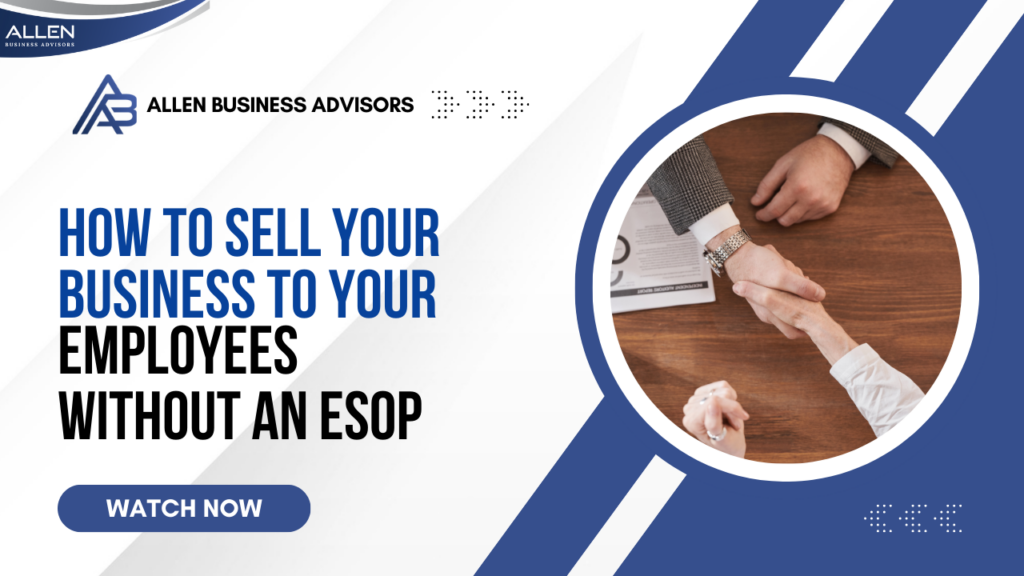

For many business owners, figuring out how to sell your business to employees is more than a financial decision—it's an emotional one. You want to preserve your company’s legacy, protect your team, and be fairly compensated for the business you built. One of the most rewarding ways to achieve this? Selling your business to a key employee. But how do you do that without the expense and complexity of an ESOP?
The answer might be simpler than you think. In this blog, we’ll explore practical alternatives to ESOPs, and why the Step-Up Legacy Plan™ is the most accessible, efficient, and rewarding path for owners ready to transition their business to the people who know it best.
What Is an ESOP (and Why Is It So Expensive)?
An ESOP (Employee Stock Ownership Plan) is a government-regulated retirement plan that invests in the stock of the sponsoring employer. It allows employees to become beneficial owners of the company over time.
While ESOPs offer tax benefits and broad-based ownership, they come with high costs:
- $80,000 to $150,000+ in setup costs
- Ongoing annual fees for administration, compliance, and valuation (starting at $40,000)
- Required ERISA compliance and Department of Labor oversight
- Complex governance and fiduciary obligations
Most companies with an EBITDA less than $1,500,000 find these costs and complexities too burdensome. (EBITDA is Net Income + Depreciation + Interest Expense + Amortization Expense.) That’s why fewer than 7,000 ESOPs exist nationwide.
The Real Cost of an ESOP: Advisor Breakdown
Designing and implementing an ESOP requires a specialized team of professionals. Here's what a typical ESOP setup looks like at New York City pricing:
AdvisorRoleEstimated CostESOP AttorneyDrafts and reviews ESOP documents; ensures ERISA compliance$40,000–$80,000Qualified Business AppraiserDetermines fair market value of stock for transaction$15,000–$30,000Third-Party Administrator (TPA)Manages compliance, participant tracking, and filings$20,000–$40,000+ annuallyESOP Investment Banking AdvisorFinancial modeling, capital sourcing, transaction oversight$30,000–$100,000+CPAProvides financials, coordination, and tax guidanceVaries (often bundled)ESOP TrusteeActs as independent fiduciary for employees$10,000–$25,000Lenders, HR, Tax & Communication ExpertsSupport functions depending on deal complexityVariable
💡 Total Estimated Setup Costs: $120,000–$250,000+
This doesn’t include the ongoing administration and valuation fees, which often exceed $50,000 per year.
That’s why ESOPs are typically reserved for companies with EBITDA of $1.5 million or more, strong management teams, and long-term planning horizons.
The Traditional Installment Sale: High Risk, Low Liquidity
The most basic way to sell your business to a key employee is via a promissory note or installment sale. You and your employee agree on a value, sign a note, and they pay you over time using company profits.
Problems with this approach:
- You get little to no cash up-front. You're essentially financing the sale yourself, and your liquidity is delayed by 5–7 years (or more).
- Risk of non-payment. If the employee struggles to maintain cash flow, your retirement funds are at risk. We call this the parent loan because if things don’t go according to plan, you take it on the chin, just as you would for your child.
- Tough negotiations. Employees may undervalue the business, and if the deal falls through, you’re left with an awkward internal dynamic.
While this method is common, it places nearly all the financial risk on the seller.
Management Buyout with Private Equity: Complex, Competitive, and Risky
Another option is to pair your employee with a private equity partner, enabling them to purchase the business together. There are two ways this typically plays out:
1. Employee Finds the Private Equity Partner
You give the employee time to find a buyer, and they return with an offer. The downside?
- You lose control of the process
- You’re stuck if the terms don’t align
- It introduces a professional buyer without competition, weakening your leverage
2. You Run a Sale Process and Include the Employee
You hire an investment banker, run a sale process targeting private equity buyers, and structure a transaction bonus or an equity carve-out for the employee.
- You maximize valuation
- Employee gets a minority stake and future growth potential
- You maintain control over who the new owner is
However, private equity firms generally look for companies with at least $3 million in EBITDA and $10 million+ in annual revenue. If your business doesn’t meet those thresholds, PE interest may be limited or non-existent.
Even when a deal is secured, the success rate of private equity transitions is often overstated. Many deals fall apart during due diligence or fail to meet the seller’s expectations post-closing. Cultural clashes, layoffs, or aggressive restructuring can threaten the legacy you hoped to protect.
How to Sell Your Business to a Key Employee Without an ESOP (The Smart Way)

If your business is valued between $500,000 and $6,000,000, and you have a loyal, capable employee or employees who could run it, you don’t need private equity or an ESOP.
You need the Step-Up Legacy Plan™.
This proprietary model enables your employees to purchase your business with little to no down payment, utilizing SBA financing in conjunction with a seller-held note, typically less than 10% of the sale price.
Step-Up Legacy Plan™ - How It Works:
- Valuation: We start by valuing your business using the same methods as the banks.
- Deal Structure:
- 90% of the sale price is financed by an SBA 7(a) loan
- 10% is financed by the seller (you) through a standby seller note if the buyer does not have the 10%. It can also be a combination of the seller and buyer.
- You Get Paid Upfront:
- 90% of the transaction value is paid at closing
- The seller note accrues interest and is repaid over time, usually starting after 24 months
- Coaching & Transition Support:
- We guide the buyer through SBA financing
- We help design the deal structure for success
- We support both parties post-closing to ensure stability
Case Study: Selling Without an ESOP
Company: Phasor Corp. https://phasorcorp.com/home
Owner: Wanted to retire and keep the business local
Seller Testimonial Jim Regan: https://bit.ly/42pJkZ5
Successors: Longtime senior team member
Buyer Testimonial Rob Ayers: https://bit.ly/4iP75Q3
Buyer Testimonial Tom Grynski: https://bit.ly/4iUKpy0
We helped structure a deal using the Step-Up Legacy Plan™. The employee received 90% SBA financing, and the seller financed the remaining 10%. The seller got liquidity at closing and stayed on as an advisor during the transition.
The result?
- Smooth ownership transfer
- No ESOP expenses or bureaucracy
- Business stayed intact with no layoffs
- Employee-owner felt confident and supported
Why This Is a Better Alternative to an ESOP
FeatureESOPStep Up Legacy Plan™Setup CostStarts at $120KPaid from sale proceedsComplexityHigh (ERISA, DOL, IRS)Low (SBA + seller note)Time12+ months6–9 monthsOwnership TypeBroad-basedSpecific key employee(s)Tax IncentivesYesPartial (SBA interest, structured sale benefits)Payment at ClosingLimited90%Ongoing CostsStarts at $50K/yearNone
Benefits of Selling to Employees Without an ESOP
- Liquidity + Legacy
You don’t have to sacrifice one for the other. You get paid, and your business continues under trusted leadership. - Minimal Disruption
Employees already understand operations, culture, and clients. That’s a smoother handoff and better continuity. - Speed and Simplicity
No ERISA compliance. No DOL oversight. No annual ESOP valuations. - Employee Motivation
Ownership unlocks drive, retention, and long-term success. When your buyer is your protégé, everyone wins.
Frequently Asked Questions (FAQ)
Q: How is the Step-Up Legacy Plan™ different from an ESOP?
An ESOP is a federally regulated retirement plan that involves extensive compliance, valuation, and oversight. The Step-Up Legacy Plan™ is a more flexible, low-cost, and personalized approach that uses SBA financing and seller support to transfer ownership to one or more key employees—without the red tape.
Q: Can my employee really qualify for an SBA loan?
Yes. With proper coaching and preparation, many employees can qualify—especially if they’ve been involved in running the business. SBA loans consider the business’s cash flow and history as much as the buyer’s personal assets or credit.
Q: What happens if the employee leaves or defaults?
That’s why deal structure matters. In our model, you get 90% of the sale price paid at closing through SBA financing. The remaining 10% is protected by a seller note with interest. If something unexpected happens, you're not left empty-handed.
Q: How long does the transition take?
Most Step-Up Legacy Plan™ transactions are completed within 6–9 months, including valuation, SBA approval, and closing.
Q: What if I have multiple employees interested in buying?
We can help you assess who is most ready, or structure a multi-buyer plan. What matters most is that the buyers are capable, committed, and aligned with your values.
Compare Your Option
OptionUpfront PaymentRisk to SellerComplexityIdeal Business Size via gross salesInstallment Sale❌ Low❌ High✅ Simple>$1,000,000ESOP❌ Low✅ Medium❌ Very High<$10,000,000Private Equity + Employee✅ Medium/High✅ Medium❌ High<$10,000,000Step-Up Legacy Plan™✅ High (90%)✅ Low✅ Moderate<$500,000 >$8,000,000
🎯 If you're under $8,000,000 in sales, the Step-Up Legacy Plan™ is often the most practical option. Learn how it works in more detail. https://www.allenbusinessadvisors.com/the-step-up-legacy-plan/
Next Steps if You’re Considering Selling to a Key Employee
✅ Identify a potential successor
✅ Order a business valuation
✅ Explore SBA financing options
✅ Schedule a confidential consultation
Final Thoughts: The Legacy You Deserve
Selling your business is one of the most important decisions of your life. If you want:
- A fair price
- A trustworthy buyer
- A smooth exit
- And a business that thrives after you
...then selling to a key employee without an ESOP may be your best move.
The Step-Up Legacy Plan™ makes it possible.
👉 Ready to explore your options?
Visit allenbusinessadvisors.com to learn more and schedule a confidential consultation.Also featured inBusiness Management Review: Top M&A Advisors: https://bit.ly/3FPakIV



